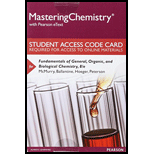
Concept explainers
Interpretation:
The geometry around the each carbon atoms of the vinyl acetate are needed to be determined.
Concept introduction:
Molecular geometry can be predicted from the structure by using the valence-shell Electron-pair repulsion (VSEPR) model.
-Count the number of valence electron pairs (bond pairs and lone pairs).
-Assume that the valence electron pairs form a structure that allows them to be as far away from each other as possible.
-If there are only two bond pair electrons, the molecule is linear.
-If there are three bond pair electrons, the molecule is shaped like a trigonal planar.
-If there are four bond pair electrons, the molecule is shaped as a regular tetrahedral.
- Repulsion between lone pair-bond pair of electrons effect the geometry of molecules.
Want to see the full answer?
Check out a sample textbook solution
Chapter 4 Solutions
Mastering Chemistry with Pearson eText -- Standalone Access Card -- for Fundamentals of General, Organic, and Biological Chemistry (8th Edition)
- List the 3 types of of macromolecules that form polymers, and next to each one list the monomers that make up each type. For the 4th type of macromolecule, explain in one sentence why its components would not really be considered monomers.arrow_forwardUsing the appropriate chemical structures describe the monomers and polymers for each of the following macromolecules; a) proteins b) carbohydratesarrow_forwardClassify the following lipid (choose all that apply).CHOOSE ALL THAT APPLY a. monounsaturated b. omega-6 c. triglyceride d. saturated e. steroid f. polyunsaturated g. omega-3 h. wax ester i. fatty acidarrow_forward
- Using the appropriate chemical structures describe the monomers and polymers for each of the following macromolecules; a) fats b) nucleic acidarrow_forwardwhich of the bonds in the molecule below are polar. explain why.arrow_forwardThiamin, or Vitamin B1, contains a positively chargedfive-membered ring called a thiazolium ring. Explainwhy the thiazolium ring is aromatic.arrow_forward
- Classify the following lipid (choose all that apply for the overall structure, not the individual residues). a. wax ester b. fatty acid c. polyunsaturated d. trans alkene(s) e. steroid f. monounsaturated g. triglyceride h. cis alkene(s) i. saturatedarrow_forwardDraw structures showing the reaction of glycerol with linoleic acid to form the triglyceride trilinolean. Would you expect this triglyceride to be a fat or an oil?arrow_forwardIdentify a polar bond within carbohydrate molecule and partial changes to the atomsarrow_forward
 Anatomy & PhysiologyBiologyISBN:9781938168130Author:Kelly A. Young, James A. Wise, Peter DeSaix, Dean H. Kruse, Brandon Poe, Eddie Johnson, Jody E. Johnson, Oksana Korol, J. Gordon Betts, Mark WomblePublisher:OpenStax College
Anatomy & PhysiologyBiologyISBN:9781938168130Author:Kelly A. Young, James A. Wise, Peter DeSaix, Dean H. Kruse, Brandon Poe, Eddie Johnson, Jody E. Johnson, Oksana Korol, J. Gordon Betts, Mark WomblePublisher:OpenStax College
